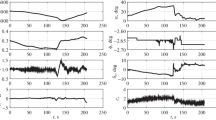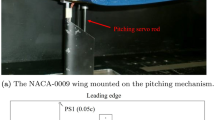Abstract
We propose an identification method for the aerodynamic coefficients of the lift force, drag force, and pitch moment in the supercritical range of angles of attack. The investigated models take into account the hysteresis with respect to the angle of attack, which is the main specific feature of aerodynamic coefficients in the specified range. Also, we consider the problem to find and correct errors of onboard measurements in the channels of the angle of attack and the air speed and the computational model for the forces and moments created by engines with a deflected thrust vector. We provide processing examples for the flight test data obtained during maneuvers on supercritical angles of attack; they confirm the efficiency of the proposed methods.
Similar content being viewed by others
References
A. Schutte, G. Einarsson, A. Raichle, B. Schoning, W. Monnich, and T. Forkert, “Numerical simulation of maneuvering aircraft by aerodynamic, flight mechanics, and structural mechanics coupling,” J. Aircraft 46, 53–64 (2009).
L. E. Ericsson, “Critical issues in high-alpha vehicle dynamics,” in Proceedings of the 9th Applied Aerodynamics Conference, Fluid Dynamics and Co-located Conference AIAA-91-3221 (Baltimore, 1991).
G. F. Lin, C. E. Lan, and J. Brandon, “A generalized dynamic aerodynamic coefficient model for flight dynamics application,” in Proceedings of the 22nd Atmospheric Flight Mechanics Conference and Exhibition AIAA-1997-3643 (New Orleans, 1997).
D. M. Luchtenburg, C. M. Rowley, M. W. Lohry, L. Martinelli, and R. F. Stengel, “Unsteady high-angle-ofattack aerodynamic models of a generic jet transport,” J. Aircraft 52, 890–895 (2015).
Q. Wang, K. F. He, W. Q. Qian, T. J. Zhang, Y. Q. Cheng, and K. Y. Wu, “Unsteady aerodynamics modeling for flight dynamics application,” Acta Mech. Sin. 28, 14–23 (2012).
Q. Wang, W. Q. Qian, and K. F. He, “Unsteady aerodynamic modeling at high angles of attack using support vector machines,” Chin. J. Aeronaut. 28, 659–668 (2015).
H. S. Sun, H. Y. Zhang, and Z. T. Liu, “Comparative evaluation of unsteady aerodynamics modeling approaches at high angle of attack,” Acta Aerodyn. Sin. 29, 733–737 (2011).
Yu. B. Dubov and V. I. Zhelonkin, “Simulation on flight engineering simulator the informational frame for research dynamics of the airplane on large angles of attack,” Nauch. Vestn. Mosk. Tekh. Univ. Grazhd. Aviats., No. 189, 126–133 (2013).
Fan Zhanqi and Liu Lin Xi’an, “The high angle of attack aerodynamic modeling and nonlinear dynamic inversion flight control law design,” in Proceedings of the IEEE 10th International Conference on Industrial Informatics (Beijing, 2012), pp. 901–905.
M. G. Efimova, I. A. Kubakov, and A. V. Naidyuk, “The plane flight specialties in large attack angles,” Nauch. Vestn. Mosk. Tekh. Univ. Grazhd. Aviats., No. 97, 151–153 (2006).
K. O. Chernigin and I. A. Kubakov, “Features of aircraft flight in large attack angles,” Nauch. Vestn. Mosk. Tekh. Univ. Grazhd. Aviats., No. 110, 12–15 (2006).
S. A. Popov and Yu. A. Gondarenko, “Mathematical model of the motion of a light attack aircraft with external load slings in the extreme area of flight modes accordings to the angle of attack,” Nauch. Vestn. Mosk. Tekh. Univ. Grazhd. Aviats. 20 (2), 65–73 (2017).
Yu. B. Dubov, V. I. Zhelonkin, and A. N. Khrabrov, “Study of lateral auto-oscillations of a maneuverable aircraft at large angles of attack,” Vestn. Mosk. Aviats. Inst. 19 (5), 5–13 (2012).
Yu. B. Dubov, “Analysis of the interaction of longitudinal and lateral motion when a maneuverable aircraft leaves a large angle of attack,” Uch. Zap. Tsentr. Aviats. Gos. Inst. 44 (2), 50–56 (2013).
V. I. Akhrameev, G. I. Dzhandzhgava, D. V. Shulepov, and V. M. Shibaev, “Research of principles and development of algorithms for diagnostics of critical flight conditions at high angles of attack, related to loss of control in lateral motion,” Aviakosm. Priborostr., No. 8, 39–57 (2015).
V. I. Petoshin and E. A. Chasovnikov, “Aerodynamic characteristics for a passenger aircraft model with harmonic oscillations on rolling and yawing angles at high angles of attack,” Thermophys. Aeromech. 20, 39 (2013).
V. I. Petoshin and E. A. Chasovnikov, “Mathematical description of nonstationary aerodynamic characteristics of a passenger aircraft model in longitudinal motion at large angles of attacki,” J. Appl. Mech. Tech. Phys. 52, 390–396 (2011).
K. A. Osipov, “Investigation of the structure of subsonic vortex flow around a model of a maneuverable aircraft using computational aerodynamics,” Uch. Zap. Tsentr. Aviats. Gos. Inst. 47 (7), 15–32 (2016).
P. V. Kuz’min, B. A. Meleshina, Yu. F. Shelyukhin, and D. V. Shukhovtsov, “Engineering model of non-stationary longitudinal aerodynamic characteristics at large angles of attack,” Uch. Zap. Tsentr. Aviats. Gos. Inst. 46 (4), 61–70 (2015).
D. V. Shukhovtsov, “Experimental study of time dependences of aerodynamic characteristics of forces and moments at large angles of attack,” Uch. Zap. Tsentr. Aviats. Gos. Inst. 31 (3–4), 149–155 (2000).
M. Bommanahal and M. Goman, “Nonlinear unsteady aerodynamic modeling by volterra variational approach,” in Proceedings of the AIAA Atmospheric Flight Mechanics Conference and Exhibition, AIAA-2012-4654 (Minneapolis, 2012).
Yongliang Chen, “Modeling of longitudinal unsteady aerodynamics at high angle-of-attack based on support vector machines,” in Proceedings of the 8th International Conference on Natural Computation (Chongqing, 2012), pp. 431–435.
Chijun Zhou, Jihong Zhu, and Humin Lei, “Aircraft longitudinal unsteady aerodynamic modeling using indicial function,” in Proceedings of the IEEE Chinese Guidance, Navigation and Control Conference CGNCC (Nanjing, 2016), pp. 1293–1298.
M. Ghoreyshi and R. M. Cummings, “Unsteady aerodynamics modeling for aircraft maneuvers: a new approach using time-dependent surrogate modeling,” Aerospace Sci. Technol. 39, 222–242 (2014).
D. I. Ignat’ev and A. N. Khrabrov, “Using artificial neural networks to simulate the dynamic effects of aerodynamic coefficients of a transonic airplane,” Uch. Zap. Tsentr. Aviats. Gos. Inst. 42 (6), 84–91 (2011).
E. A. Dorofeev, D. I. Ignat’ev, and A. N. Khrabrov, “Application of artificial neural networks for modeling of non-stationary aerodynamic characteristics,” Tr. Mosk. Fiz. Tekh. Univ. 3 (2), 15–25 (2011).
D. P. Tapolcai, A. Omran, and B. Newman, “Aircraft stall phenomenon analysis using nonlinearity index theory,” Aerospace Sci. Technol. 68, 288–298 (2017).
R. C. Paul, J. Murua, and A. Gopalarathnam, “Unsteady and post-stall aerodynamic modeling for flight dynamics simulation,” in Proceedings of the AIAA Atmospheric Flight Mechanics Conference AIAA 2014-0729 (Atlanta, 2014).
D. Pucci, “Flight dynamics and control in relation to stall,” in Proceedings of the American Control Conference (Montreal, 2012), pp. 118–124.
M. I. Radchenko, “A method for airplane motion simulation at stalling angles,” Nauch. Vestn. Mosk. Tekh. Univ. Grazhd. Aviats., No. 192, 89–95 (2013).
H. A. Carlson, R. Verberg, M. S. Hemati, and C. W. Rowley, “A flight simulator for agile fighter aircraft and nonlinear aerodynamics,” in Proceedings of the 53rd AIAA Aerospace Sciences Meeting, AIAA 2015-1506 (Kissimmee, 2015).
K. Ghosh, A. Paranjape, and N. Ananthkrishnan, “Effect of thrust vectoring on aircraft post—stall trims, stability, and maneuvers,” in Proceedings of the AIAA Atmospheric Flight Mechanics Conference and Exhibition (Keystone, 2006).
A. V. Kanyshev, O. N. Korsun, and A. V. Stulovskii, “Methods of computing thrust vector coordinates for aircrafts equipped with thrust vector control,” in Proceedings of the Seminar on Systems Analysis, Moscow, ITM Web of Conf. 10 (2017).
M. G. Goman and A. N. Khrabrov, “State-space representation of aerodynamic characteristics of an aircraft at high angles of attack,” J. Aircraft 31, 1109–1115 (1994).
Aerodynamics, Stability and Controllability of Supersonic Aircraft, Ed. by G. S. Buschgens (Nauka, Moscow, 1998) [in Russian].
V. V. Bulgakov, O. N. Korsun, V. S. Kulabukhov, A. V. Stulovskii, and D. S. Timofeev, “Algorithms of increasing the calculation accuracy for an aircraft’s orientation angle,” J. Comput. Syst. Sci. Int. 55, 150 (2016).
V. Klein and E. A. Morelli, Aircraft System Identification: Theory and Practice (AIAA, Reston, USA, 2006).
R. V. Jategaonkar, Flight Vehicle System Identification: A Time Domain Methodology (AIAA, Reston, USA, 2006).
V. N. Ovcharenko, Identification of Aerodynamical Characteristics of Aircraft from Flight Data (Mosk. Aviats. Inst., Moscow, 2017) [in Russian].
O. N. Korsun and B. K. Poplavsky, “Approaches for flight tests aircraft parameter identification,” in Proceedings of the 29th Congress of the International Council of the Aeronautical Sciences ICAS 2014 (St. Petersburg, 2014), Paper No. 2014-0210.
S. L. Brunton, S. T. M. Dawson, and C. W. Rowley, “State-space model identification and feedback control of unsteady aerodynamic forces,” J. Fluids Struct. 50, 253–270 (2014).
O. N. Korsun, S. V. Nikolaev, and B. K. Poplavskii, “Algorithms for validation of the flight data and evaluation of the nonlinearities of the aerodynamic coefficients of the aircraft,” Mekhatron., Avtomatiz., Upravl. 18, 270–278 (2017).
O. N. Korsun and S. V. Nikolaev, “Identification of the aerodynamic coefficients of longitudinal motion of an aircraft in the operational range of the attack angles,” Mekhatron., Avtomatiz., Upravl. 16, 269–276 (2015).
O. N. Korsun and S. V. Nikolaev, “Aircraft aerodynamic coefficients identification in the angle of attack operational range,” Vestn. Komp’yut. Inf. Tekhnol., No. 9 (147), 3–10 (2016).
Y. Wang, J. Dong, X. Liu, and L. Zhang, “Identification and standardization of maneuvers based upon operational flight data,” Chin. J. Aeronaut. 28, 133–140 (2015).
Y. Song, B. Song, B. Seanor, et al., “On-line aircraft parameter identification using fourier transform regression with an application to F/A-18 HARV flight data,” KSME Int. J. 16, 327–337 (2002).
GOST (State Standard) No. 20058-80, Dynamics of aircrafts in atmosphere, terms, definitions and designations (1981).
Yu. S. Zav’yalov, B. I. Kvasov, and V. L. Miroshnichenko, Spline-Functions Methods (Nauka, Moscow, 1980) [in Russian].
A. P. Karpenko, Modern of Search Optimization Algorithms (MGTU im. N.E. Baumana, Moscow, 2014) [in Russian].
H. Boubertakh, “Knowledge-based ant colony optimization method to design fuzzy proportional integral derivative controllers,” J. Comput. Syst. Sci. Int. 56, 681–700 (2017).
Author information
Authors and Affiliations
Corresponding author
Additional information
Original Russian Text © A.V. Kanyshev, O.N. Korsun, V.N. Ovcharenko, A.V. Stulovskii, 2018, published in Izvestiya Akademii Nauk, Teoriya i Sistemy Upravleniya, 2018, No. 3, pp. 33–47.
Rights and permissions
About this article
Cite this article
Kanyshev, A.V., Korsun, O.N., Ovcharenko, V.N. et al. Identification of Aerodynamic Coefficients of Longitudinal Movement and Error Estimates for Onboard Measurements of Supercritical Angles of Attack. J. Comput. Syst. Sci. Int. 57, 374–389 (2018). https://doi.org/10.1134/S1064230718030048
Received:
Accepted:
Published:
Issue Date:
DOI: https://doi.org/10.1134/S1064230718030048




